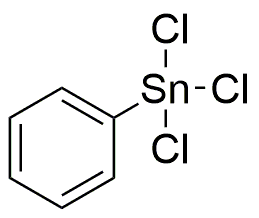Phenyltin trichloride is widely utilized in research focused on:
- Wood Preservation: This compound is effective in protecting wood from fungal decay and insect damage, making it valuable in the construction and furniture industries.
- Biocides: It serves as a biocide in agricultural applications, helping to control pests and diseases in crops, thereby enhancing agricultural productivity.
- Organotin Chemistry: Researchers use it as a precursor in synthesizing other organotin compounds, which are important in various chemical reactions and formulations.
- Polymer Stabilization: Phenyltin trichloride is utilized in the production of PVC and other polymers, providing thermal stability and improving material longevity.
- Analytical Chemistry: It is employed in analytical methods for detecting and quantifying tin compounds in environmental samples, aiding in pollution monitoring and regulatory compliance.
General Information
Properties
Safety and Regulations
Applications
Phenyltin trichloride is widely utilized in research focused on:
- Wood Preservation: This compound is effective in protecting wood from fungal decay and insect damage, making it valuable in the construction and furniture industries.
- Biocides: It serves as a biocide in agricultural applications, helping to control pests and diseases in crops, thereby enhancing agricultural productivity.
- Organotin Chemistry: Researchers use it as a precursor in synthesizing other organotin compounds, which are important in various chemical reactions and formulations.
- Polymer Stabilization: Phenyltin trichloride is utilized in the production of PVC and other polymers, providing thermal stability and improving material longevity.
- Analytical Chemistry: It is employed in analytical methods for detecting and quantifying tin compounds in environmental samples, aiding in pollution monitoring and regulatory compliance.
Documents
Safety Data Sheets (SDS)
The SDS provides comprehensive safety information on handling, storage, and disposal of the product.
Product Specification (PS)
The PS provides a comprehensive breakdown of the product’s properties, including chemical composition, physical state, purity, and storage requirements. It also details acceptable quality ranges and the product's intended applications.
Certificates of Analysis (COA)
Search for Certificates of Analysis (COA) by entering the products Lot Number. Lot and Batch Numbers can be found on a product’s label following the words ‘Lot’ or ‘Batch’.
*Catalog Number
*Lot Number
Certificates Of Origin (COO)
This COO confirms the country where the product was manufactured, and also details the materials and components used in it and whether it is derived from natural, synthetic, or other specific sources. This certificate may be required for customs, trade, and regulatory compliance.
*Catalog Number
*Lot Number
Safety Data Sheets (SDS)
The SDS provides comprehensive safety information on handling, storage, and disposal of the product.
DownloadProduct Specification (PS)
The PS provides a comprehensive breakdown of the product’s properties, including chemical composition, physical state, purity, and storage requirements. It also details acceptable quality ranges and the product's intended applications.
DownloadCertificates of Analysis (COA)
Search for Certificates of Analysis (COA) by entering the products Lot Number. Lot and Batch Numbers can be found on a product’s label following the words ‘Lot’ or ‘Batch’.
*Catalog Number
*Lot Number
Certificates Of Origin (COO)
This COO confirms the country where the product was manufactured, and also details the materials and components used in it and whether it is derived from natural, synthetic, or other specific sources. This certificate may be required for customs, trade, and regulatory compliance.


